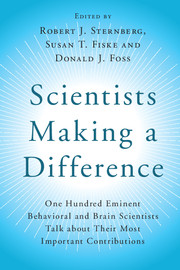 Scientists Making a Difference
Scientists Making a Difference Book contents
- Frontmatter
- Contents
- List of Contributors
- Foreword: Making a Creative Difference = Person × Environment
- Preface
- Part I Introduction
- Part II Biological Bases of Psychology: Genes, Brain, and Beyond
- Part III Cognition: Getting Information from the World and Dealing with It
- Part IV Development: How We Change Over Time
- Part V Motivation and Emotion: How We Feel and What We Do
- Part VI Social and Personality Processes: Who We Are and How We Interact
- Part VII Clinical and Health Psychology: Making Lives Better
- Part VIII Conclusion
- Afterword: Doing Psychology 24×7 and Why It Matters
- Index
- References
Afterword: Doing Psychology 24×7 and Why It Matters
Published online by Cambridge University Press: 05 August 2016
- Frontmatter
- Contents
- List of Contributors
- Foreword: Making a Creative Difference = Person × Environment
- Preface
- Part I Introduction
- Part II Biological Bases of Psychology: Genes, Brain, and Beyond
- Part III Cognition: Getting Information from the World and Dealing with It
- Part IV Development: How We Change Over Time
- Part V Motivation and Emotion: How We Feel and What We Do
- Part VI Social and Personality Processes: Who We Are and How We Interact
- Part VII Clinical and Health Psychology: Making Lives Better
- Part VIII Conclusion
- Afterword: Doing Psychology 24×7 and Why It Matters
- Index
- References
Summary
Careers, like much of life, are funny things, rarely following a linear, predictable course, but often carrying forward a theme expressed in a multitude of ways. I started my “career” as a psychologist as a child riding the New York City subways back and forth to school, soaking in the energy and vibrancy of the diversity in the faces in those crowded cars, always wondering what each person's story was and where they were going, what they believed in and how they and I would all get along and make it to our destinations, being so different both on the surface and surely beneath it.
That theme – the complexity and diversity of individuals and the challenge and opportunity for us to travel together – still fascinates me. It motivated me as a student and then a faculty member to pursue both laboratory and field research in social and personality psychology, but always with an interest in the “real world,” and how what we did in academia could make life better beyond it. And I haven't been disappointed, even if there is much more to do.
As the range of the essays in this remarkable volume attest, psychological science has unpacked everything from the plasticity of the brain to the toughest questions of human aggression and violence, and there is still so much more that we can learn about why human beings sometimes do and often don't live up to our potential as “social animals,” as Elliot Aronson so compellingly labelled us.
Now as a university chancellor, so many years after I first read The Social Animal and thought back to those faces on the NYC subway, colleagues and friends often ask me why I gave up psychology for academic leadership (as a chair, dean, provost, and then chancellor). And, frankly, I look at them as if they are crazy and say “What? I do psychology 24x7 in this job” – and that is the beauty and power of psychological science. It is everywhere and it matters.
I do psychology when I think about how to recognize talent in the children in our communities who are often left out of the “race to the top,” especially those whose “intelligence” and “creativity” might not be captured by narrow indicators on standardized tests used for selecting who gets the chance to excel in life that education affords.
- Type
- Chapter
- Information
- Scientists Making a DifferenceOne Hundred Eminent Behavioral and Brain Scientists Talk about Their Most Important Contributions, pp. 493 - 496Publisher: Cambridge University PressPrint publication year: 2016
